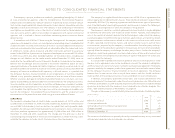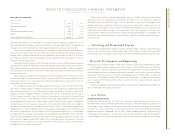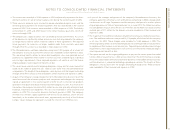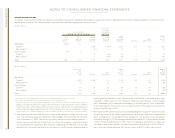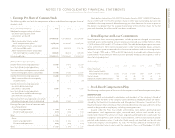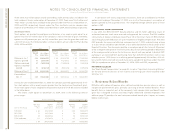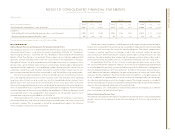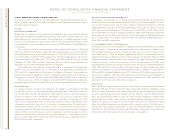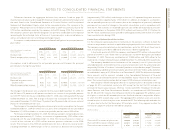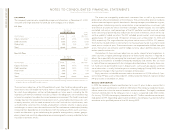IBM 2004 Annual Report Download - page 82
Download and view the complete annual report
Please find page 82 of the 2004 IBM annual report below. You can navigate through the pages in the report by either clicking on the pages listed below, or by using the keyword search tool below to find specific information within the annual report.
NOTES TO CONSOLIDATED FINANCIAL STATEMENTS
International Business Machines Corporation and Subsidiary Companies
80
ibm annual report 2004
defined benefit and defined contribution plans
The company and its subsidiaries have defined benefit and defined contribution pension
plans that cover substantially all regular employees, and supplemental retirement plans
that cover certain executives.
U.S. Plans
IBM PERSONAL PENSION PLAN
IBM provides U.S. regular, full-time and part-time employees with noncontributory defined
benefit pension benefits (the IBM Personal Pension Plan, “PPP”). The PPP comprises a tax
qualified plan and a non-qualified plan. The qualified plan is funded by company contri-
butions to an irrevocable trust fund, which is held for the sole benefit of participants. The
non-qualified plan, which provides benefits in excess of IRS limitations for qualified plans,
is unfunded.
The number of individuals receiving benefits from the PPP at December 31, 2004 and
2003, was 139,804 and 136,302, respectively. The net periodic pension cost/(income) for
the qualified plan for the years ended December 31, 2004, 2003 and 2002, was $30 mil-
lion, $(692) million and $(917) million, respectively. The net periodic pension cost for the
non-qualified plan was $108 million, $107 million and $106 million for the years ended
December 31, 2004, 2003 and 2002, respectively. The costs of the non-qualified plan are
reflected in Cost of other defined benefit plans on page 81.
The funded status reconciliation for the qualified plan is on page 82. The benefit obli-
gation of the non-qualified plan was $1,116 million and $1,068 million at December 31,
2004 and 2003, respectively, and the amounts included in Retirement and nonpension
postretirement benefit obligations in the Consolidated Statement of Financial Position at
December 31, 2004 and 2003, were liabilities of $968 million and $901 million, respectively.
Effective January 1, 2005, the company amended the PPP to provide that employees
hired on and after such date, including rehires, will not be eligible to participate in this plan.
IBM SAVINGS PLAN
U.S. regular, full-time and part-time employees are eligible to participate in the IBM
Savings Plan, which is a tax-qualified defined contribution plan under section 401(k) of
the Internal Revenue Code. For employees hired prior to January 1, 2005, the company
matches 50 percent of the employee’s contribution up to the first 6 percent of the
employee’s compensation. For employees hired or rehired after December 31, 2004
who have also completed one year of service, the company matches 100 percent of the
employee’s contribution up to the first 6 percent of compensation. All contributions,
including the company match, are made in cash, in accordance with the participants’
investment elections. There are no minimum amounts that must be invested in company
stock, and there are no restrictions on transferring amounts out of the company’s stock to
another investment choice. The total cost of all of the company’s U.S. defined contribution
plans was $338 million, $333 million and $315 million for the years ended December 31,
2004, 2003 and 2002, respectively.
IBM EXECUTIVE DEFERRED COMPENSATION PLAN
The company also maintains an unfunded, non-tax-qualified, defined contribution plan,
the IBM Executive Deferred Compensation Plan (EDCP), which allows eligible U.S. execu-
tives to defer compensation, and to receive company matching contributions under the
applicable IBM Savings Plan formula described above, with respect to amounts in excess
of IRS limits for tax-qualified plans. The total cost of the IBM EDCP was $9 million, $9 mil-
lion and $8 million for the years ended December 31, 2004, 2003 and 2002, respectively.
These amounts are included in the total cost of all of the company’s defined contribution
plans of $338 million, $333 million and $315 million for the years ended December 31,
2004, 2003 and 2002, respectively.
U.S. SUPPLEMENTAL EXECUTIVE RETENTION PLAN
The company also has a non-qualified U.S. Supplemental Executive Retention Plan (SERP).
The SERP, which is unfunded, provides defined benefit pension benefits in addition to the
PPP to eligible executives based on average earnings, years of service and age at retire-
ment. Effective July 1, 1999, the company adopted the SERP (which replaced the previous
Supplemental Executive Retirement Plan). Some participants of the prior SERP will still be
eligible for benefits under that plan if those benefits are larger than benefits provided
under the new plan. Certain former partners of PwCC also participate in the SERP under
two separate benefit formulas. The total cost of this plan for the years ended December 31,
2004, 2003 and 2002, was $22 million, $25 million and $18 million, respectively. These
amounts are reflected in Cost of other defined benefit plans on page 81. At December 31,
2004 and 2003, the benefit obligation was $191 million and $181 million, respectively, and
the amounts included in Retirement and nonpension postretirement benefit obligations in
the Consolidated Statement of Financial Position at December 31, 2004 and 2003, were
liabilities of $203 million and $186 million, respectively.
Non-U.S. Plans
Most subsidiaries and branches outside the United States have defined benefit and/or
defined contribution retirement plans that cover substantially all regular employees, under
which the company deposits funds under various fiduciary-type arrangements, purchases
annuities under group contracts or provides reserves. Benefits under the defined benefit
plans are typically based either on years of service and the employee’s compensation,
generally during a fixed number of years immediately before retirement, or on annual
credits. The range of assumptions that are used for the non-U.S. defined benefit plans
reflects the different economic environments within various countries. The total non-U.S.
pension plan cost/(income) of these plans for the years ended December 31, 2004, 2003
and 2002, was $572 million, $254 million and $(46) million, respectively. The funded status
reconciliation for the principal non-U.S. pension plans is on page 82.



